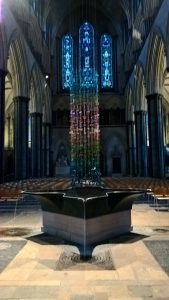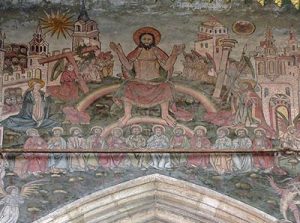I have had an uplifting couple of days visiting Salisbury, an old haunt where I was confirmed and where my sons were at school, and then driving down to Devon through the most beautiful landscapes of autumn. What a stunning country we live in. I do enjoy the changes of the seasons, the sweeps of fields, hills and golden woods. I enjoyed noticing the horses, cows and sheep grazing on the green grass and my journey was an enriching experience. I felt fortunate to inhabit such beauty.
And I have been questioning how it is that I know those things that uplift me but don’t always make sufficient time for them. It’s so easy to get buried in emails and lost surfing the internet. All very interesting but this seldom raises my spirits in the way that, say, standing under a night sky does. When I had a flat in Nice I would sit on my balcony almost every night looking up at the stars but now I live in the countryside, where the sky is clearer and less light-polluted, I hardly ever remember to get my fix of wonder by going out into the garden and looking up. More fool me.
So I have been thinking about what it is that makes one person experience a sense of awe from being in a sunset or a sacred place and another from being in a science lab. Where do you gain your sense of wonder?
For me it’s cathedrals. Put me in a cathedral with a choir singing and I am transported to another realm. I can’t help but experience a sense of wonder. I don’t have to think about it. It just happens. I look at the beauty of the stained glass, carved wood, towering arches and something happens inside me, unbidden. Awe.
I was visiting Salisbury in the hope of finding the gravestone of an ancestor, Thomas Bucknall. He is recorded on our family tree as having been buried in St Edmund’s Church Salisbury in 1783. And so I spent Sunday afternoon wandering around damp graveyards only to discover that St Edmunds is now deconsecrated and has become an Arts Centre. No-one I spoke to seemed to be clear about what had happened to the graves.
And so I moved on to the church of St Thomas, in the centre of Salisbury, to see if anyone there knew where I might find information, as the parishes were amalgamated in 1973 becoming St Thomas and St Edmund’s. What a delight that was – a chapel with medieval wall paintings and, above the Chancel in the main church, a Doom Painting, depicting a Bishop being dragged to hell. But the concept of doom brought my mind back to the US election, to Syria, Brexit, Mosul and the hope that doom would not be coming our way soon.
I have always been drawn to sacred spaces and sacred music. I don’t really know why as my parents weren’t particularly religious. I think it may have been due to my prep school headmaster, John Booker, or Mr B as we called him, at Knighton House in Dorset. The Bookers had created a simple white chapel in the basement of the school and Mr B took our services. I still remember him often, as a warm, wise and spiritual man. His wife, Peggy, led the choir and carol services in the local church in Durweston. For me it was a special time and I continued to enjoy going to church even though my next school, Cranborne Chase, did not push religion down our throats and many of my friends weren’t interested. But we were encouraged to think about what it meant and to me it resonated and has been a part of my life ever since.
David and I are lucky to have Winchester, Chichester and Salisbury cathedrals all within a short distance and can go to services or listen to sacred music. On our travels in Russia and Eastern Europe we visited Orthodox churches with exquisite wall paintings and were given concerts by black-robed Orthodox priests with their sonorous bass voices. Fabulous.
And so on Sunday night, to shelter from the cold and from the potential doom of the US election, I took myself to evensong in Salisbury Cathedral. As I walked down the nave that familiar sense of wonder took me over. I looked up to the ancient stones and thought of the history of the kings and bishops who had walked the flagstones over the centuries. And felt angry again that the government are potentially dropping History of Art from the school curriculum. Whether or not you believe in Christianity these churches and cathedrals and the art within them hold our history. I remember my mother being horrified by a young woman next to her in a jewellery shop who looked at a gold crucifix on a chain and asked, “who’s that little man?” Will generations to come know anything about the stories and beliefs that have shaped our past?
I have noticed that a building takes on the energy of what happens within it. For me a cathedral presents an energy of wisdom, as if the centuries of worship and song have seeped into the stones, encouraging us to be still, to reflect and question what we can learn so as to access the better part of ourselves as we go back out into the world.
The bishop spoke of truth and wisdom in a thinly-veiled attack on the “post-truth” politics of Trump and Clinton. He reminded us of the Magna Carta housed in Salisbury Cathedral, implying that we should take the judiciary seriously. And the choir sang the Nunc Dimitis and Magnificat, their pure young voices echoing around the aisles. Truth, wisdom, forgiveness and love, yes, good values to hold within us whether we believe in Jesus Christ or not.
I left feeling uplifted, reminding myself that it is up to me to seek out these moments. They exist if we look for them – in the night sky, in music, a painting, a sunrise, in the innocence of a child, a cathedral. In this uncertain world we can still find wonder. Each of us will see awe in different places. It’s up to us to make it happen.



Recent Comments